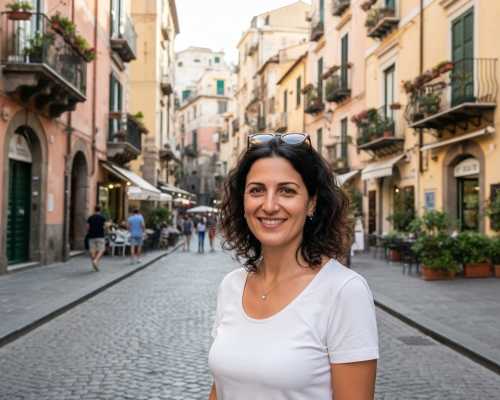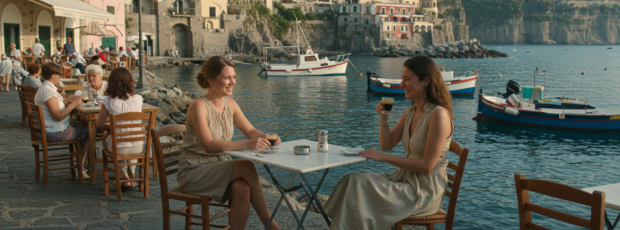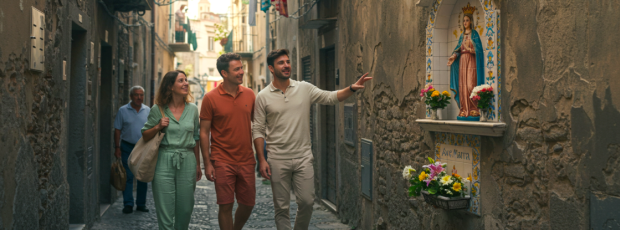We did a walking tour around Sorrento with Giovanni. He was so wonderfully informative and catered to our wishes to see things a bit off the beaten track. He certainly loves his work. Highly recommend a tour with Giovanni.Melissa, Sorrento, 2025
Table Of Contents
- Why February in My Hometown Feels Magical
- Learning Sorrento Weather Rhythms: Rain, Mist, and Perfect Light
- Exploring Sorrento's Historic Center and Hidden Amalfi Coast Gems
- Celebrating Like a Local: Sant'Antonino's Feast Day
- Day Trips from Sorrento: Pompeii, Naples, and Amalfi Coast Adventures
- Food and Restaurants: Beyond Tourist Menus in Sorrento
- Following My Own Rhythms in Sorrento: Hiking, Cafés, and Slow Discoveries
- Planning Your Sorrento Trip: What Winter Really Requires
- Frequently Asked Questions on Sorrento in February
- What February Reveals When You Live Here
Most travel disasters become the stories you tell for years afterward. Years before I settled here full-time, a February flight cancellation trapped me in Sorrento during what every guidebook calls the “dead season.” I braced myself for shuttered restaurants, empty streets, and three days of buyer's remorse.
What I discovered instead changed how I think about travel entirely, and ultimately why I stayed.

Misty Sorrento seafront with Bay of Naples in winter
The Sorrento experiences that unfold in winter exist in a parallel universe to the summer guidebooks. This is where Signora Rossi debates morning politics with the baker while remembering exactly how you take your coffee. Her grandson's violin scales drift from the apartment above, mixing with church bells and the sounds of locals going about their lives. This is Sorrento when it belongs to the people who call it home. Not the cruise ships, not the tour groups, not even well-meaning travelers like me.
February transforms this Amalfi Coast jewel from a destination into something far more valuable: a genuine community that welcomes you in. I've watched morning mist rise from the Bay of Naples while my footsteps echoed off medieval stones, creating the only soundtrack aside from distant conversations in rapid Italian. The temperature hovers between 54–59°F (12–15°C). It's cool enough to make you appreciate warm cafés, mild enough for hours of wandering without summer's crushing heat.
Why February in My Hometown Feels Magical
Winter reveals layers of authentic Italian life that summer's chaos completely obscures.
Most Tourists Miss Sorrento's Authentic Winter Character
I've lived through every season here. Winter holds something the others can't touch. Cruise ships vanish, most tourists disappear, and suddenly you can hear what this ancient city is saying. Visit Sorrento during these quiet months, and you'll discover a completely different place from the crowded Amalfi destination most people know.

Quiet Sorrento square in winter with a few locals
Last winter, I spent an entire afternoon in Piazza Tasso with only three other people, two elderly locals playing cards and a woman feeding stray cats. During summer, that same square seethes with hundreds of visitors from cruise ships and tour buses. In the colder months, Sorrento welcomes you like a guest rather than another tourist.
Many Businesses Close: Creating Authentic Local Experiences
Many businesses that cater exclusively to summer crowds close during winter. This creates liberation rather than limitation. The restaurants that stay open feed neighbors from traditional Italian houses nearby. At Il Buco, Maria shared stories about her grandmother's recipes while I waited for gnocchi alla sorrentina that tasted nothing like the tourist versions. This is food that only locals usually get to enjoy.

Chef making fresh pasta in a Sorrento restaurant
Why Winter Hotel Stays Feel More Personal
Friends who visit in winter often find hotels for about half the summer price, and the staff have time to remember your name. At Villa Crawford, Giuseppe spent an hour walking my friends through the stories behind the paintings in their room, then invited us on his evening stroll along Marina Grande. These interactions don’t happen when hotels manage hundreds of guests during peak season. In winter, staff have time to connect, share stories, and make their stay genuinely memorable.

Hotel concierge speaking with guest in a welcoming lobby
Looking for a Private City Experience in Sorrento?
Explore the city with a local who plans a private day just for you; no groups, no scripts.
Learning Sorrento Weather Rhythms: Rain, Mist, and Perfect Light
Understanding winter weather patterns changed how I plan my days, from fighting conditions to embracing them.
Average Temperature and Good Weather for Exploring
The first time I experienced Sorrento's winter weather, I made every mistake possible. I packed for harsh cold, expecting freezing temperatures. By noon, I found myself shedding layers when good weather returned and temperatures reached 59°F (15°C). The morning started at 50°F (10°C) with mist rolling off the sea, perfect for walking without sweating through my jacket.

Woman strolling a quiet Sorrento Street on a mild winter day
Three winters living here taught me this: the weather follows patterns that prepared travelers learn to appreciate. Rain arrives most afternoons between 2–4 PM, lasting just long enough to drive everyone into cafés where real conversations happen. I learned to carry a light rain jacket and embrace these interludes rather than fight them.
Winter Storms Create Stunning Views Along the Coast
The light after winter storms? I've never seen anything like it. Air clears so completely that Mount Vesuvius appears close enough to touch. The Bay of Naples turns colors I didn't know water could be. I've shot some of my best photos during these post-rain golden hours when the whole coast seems to glow with stunning views.

Mount Vesuvius and the Bay of Naples in dramatic golden light after winter storm
Local shopkeepers dress in layers: a light sweater, maybe a scarf they can remove by afternoon. I copy them and find I can walk for hours comfortably, from sea level up to Sorrento's highest viewpoints. The coast reveals different moods when you're dressed appropriately for the season.
On a quiet morning, I noticed medieval door knockers, read inscriptions carved into doorway stones, and discovered tiny shrines tucked into building corners that summer visitors never see.
Exploring Sorrento's Historic Center and Hidden Amalfi Coast Gems
Winter exploration unveils both obvious attractions without crowds and secret locations most visitors never discover.
Walking Through the Historic Center Like Only Locals Do
Via San Cesareo in the historic center becomes a personal theater during the winter months. I've walked this main thoroughfare shoulder-to-shoulder with crowds in summer, missing every architectural detail. On a quiet morning, I noticed medieval door knockers, read inscriptions carved into doorway stones, and discovered tiny shrines tucked into building corners that summer visitors never see. Every person I passed had time to nod hello rather than push past.

Quiet cobblestone lane in Sorrento's historic center in winter
The 15th-century Loggia di Sedile Dominova sits empty most days in the off-season. I spent an hour studying the frescoed ceiling, imagining the nobility who once debated here in this ancient city center. The guide at Museo Correale di Terranova had time to explain how families assembled their collections, pointing out pieces that revealed Sorrento's connections to Naples and the broader Mediterranean world.
I wandered residential neighborhoods where children played in small piazzas while grandparents watched from traditional houses. These areas show how Italian family life actually works, far from tourist sites along the main coastal routes. I've watched three generations gather for Sunday lunch on terraces overlooking lemon groves, glimpsing domestic routines unchanged for decades.
Discovering Sorrento's Hidden Natural Beauty Along the Coast
Winter offers perfect conditions for discovering the most enchanting hidden gems in Sorrento along this stretch of the coast. I often detour to Bagni della Regina Giovanna on morning walks, following olive grove paths until I reach this secluded cove with ancient Roman ruins. The natural swimming pool formed by ancient breakwaters was mine alone, no crowds, no noise, just history and sea. Even though it wasn't beach weather, this hidden spot's beauty took my breath away.

Overgrown stone mill ruins covered by vegetation Mediterranean landscape
The mysterious Vallone dei Mulini feels like discovering a lost civilization in Sorrento. These overgrown mill ruins hide in plain sight, where nature has reclaimed industrial structures from centuries past. Winter's reduced vegetation reveals stone foundations and mechanical elements that demonstrate ingenious pre-industrial engineering. Some evenings in spring, locals tell me, the mills come alive with guided night tours.
Parco Ibsen is my retreat for reading and reflection. This quiet garden, dedicated to Norwegian playwright Henrik Ibsen, incorporates Mediterranean plants that create micro-environments perfect for contemplation. I understand why Ibsen found creative inspiration here. The combination of natural beauty and literary history creates a uniquely peaceful atmosphere away from busy coastal roads.
What If Exploring a City Felt More Personal?
City Unscripted pairs you with someone who lives there, so you can see iconic sights and hidden corners in a way that feels like yours.
Celebrating Like a Local: Sant'Antonino's Feast Day
Every February 14, we celebrate the feast of Sant’Antonino, our patron saint, and it still deepens how I understand Sorrento’s cultural soul. Local families dress in traditional clothing for a procession that has continued for centuries. Children walk alongside grandparents carrying the patron saint's statue through routes connecting the town's most sacred spaces. This celebration happens every year on Valentine's Day, intended as a spiritual holiday rather than a tourist attraction.

The Sant'Antonino procession through Sorrento streets
The small market that appears during the celebration serves the community while honoring Sant'Antonino. I watched elderly women examine handmade crafts, families purchase traditional foods, and artisans demonstrate techniques passed down through generations. This wasn't a performance. It was authentic cultural continuity.
In the evening, we gather for community meals where conversations range from local politics to family histories, sharing tables with people whose families have marked this feast for generations.
Embrace the Off-Season
Winter in Sorrento means fewer crowds, lower prices, and locals with time to share their stories. It’s Italy at its most authentic.Day Trips from Sorrento: Pompeii, Naples, and Amalfi Coast Adventures
From Sorrento, it’s easy to reach the region’s big hitters without the summer crowds.
Visit Pompeii Without Crowds from Sorrento
Winter day trips from Sorrento reveal destinations in ways summer visits never could. Pompeii, without busloads of visitors, becomes an archaeological site where I can contemplate this ancient city. Walking empty streets, I hear my footsteps echo off 2,000-year-old stones and can imagine daily routines without competing with hundreds of other people for space and contemplation. The train from Sorrento to Pompeii runs regularly, making it an easy day trip that every person visiting this area should consider.

Empty Pompeii street with Mount Vesuvius in soft winter light
Exploring Naples and the Amalfi Coast by Train and Ferry
The train journey itself offers insights into regional life along the Amalfi Coast. I often share compartments with commuters heading to work, observing authentic social interactions and understanding how public transportation systems actually function throughout southern Italy.

Small ferry boat on blue Mediterranean waters near rocky coast
Naples reveals its unfiltered character as Italy's most passionate city. Without the tourist infrastructure overwhelming local life, I experience Naples as residents do. Chaotic, welcoming, food-obsessed, and utterly genuine. Street vendors serve pizza to neighbors rather than visitors. Neighborhood energy focuses on community concerns rather than visitor management.
Ferries to the island of Capri run on reduced schedules, creating more intimate experiences during my coastal explorations. With fewer day-trippers, I see natural beauty without crowds, and boat rides offer spectacular coastal views from Sorrento's perspective. You can also take a bus to Positano, which reveals its character as a clifftop village where residents go about their winter routines. The coast shows different personalities when it isn’t overwhelmed by summer traffic.
Hungry to Try Sorrento Yourself?
Taste and explore the flavors locals actually love.
Food and Restaurants: Beyond Tourist Menus in Sorrento
Winter dining connects you directly with authentic regional food culture that summer's commercial pressure completely transforms.
Family Restaurants Serve Food Made for Locals
My most memorable Sorrento meals happened in winter restaurants serving residents rather than passing visitors along busy coastal routes. At a family-run trattoria near the cathedral, three generations worked the kitchen while I watched nonno roll gnocchi using techniques his grandmother taught him. The gnocchi alla sorrentina showcased ingredients from their own suppliers, San Marzano tomatoes from a farm they'd known for decades, mozzarella made by a neighbor, and basil grown in their garden.

Gnocchi alla sorrentina served in a pan with tomato sauce and basil
Seafood restaurants along Marina Grande operate for neighborhood families during the off-season. I watched fishermen dock their boats while restaurant owners examined the daily catch, deciding menus based on what the sea provided rather than tourist expectations. My dinner of sea bream is usually the morning’s catch, prepared simply to highlight flavor rather than disguised with elaborate sauces.
Local Food Markets and Authentic Italian Hospitality
Winter dining's pace in Sorrento transforms every meal into a cultural education. Servers have time to explain family recipes, restaurant owners share stories about ingredient sources, and conversations stretch through multiple courses without pressure to turn tables. You can search for this kind of authentic experience, but it only emerges when locations aren't overwhelmed by crowds from cruise ships visiting Italy's major ports.

Italian market stall piled with lemons and citrus
Markets in Sorrento operate for residents, revealing what people actually buy and cook along this stretch of the coast. Famous Sorrento lemons reach peak quality in winter, and vendors explain how residents use different citrus varieties in cooking. Some evenings, I buy ingredients at these markets and cook at home. Then I walk back through my neighborhood past traditional houses where families gather for night meals.
Following My Own Rhythms in Sorrento: Hiking, Cafés, and Slow Discoveries
Winter activities emphasize quality over quantity, depth over surface-level sightseeing. The best things to do in Sorrento during the quieter months aren't found on typical itineraries. They emerge from slowing down enough to notice what locals actually value.
Hiking and Walking Sorrento's Coast Without Crowds
Winter hiking around Sorrento offers trails entirely to yourself along this beautiful stretch of the Amalfi Coast. The famous Sentiero degli Dei (Path of the Gods) becomes a personal meditation rather than a crowded procession. Cool temperatures make longer walks comfortable, and winter light creates photographic opportunities impossible during summer's harsh brightness. The silence allows me to hear natural sounds, birds calling through olive groves, wind moving through valley corridors, and distant church bells marking hours.

Hiker on misty coastal trail near Sorrento in winter
Walking through Sorrento's lemon groves in winter reveals agricultural landscapes that summer visitors rarely experience authentically along the coast. I watch farmers work the land according to seasonal rhythms rather than tourist schedules, understanding how citrus cultivation has sustained families for centuries. The fruit is at peak ripeness. Trees show different growth patterns than in spring. These insights only emerge when you have time to observe carefully.
Sorrento's Café Culture and Morning Rituals
Morning walks become meditation during the quieter months in Sorrento. I encounter residents opening shops, heading to work, and moving through daily routines that visitors rarely witness. Coffee shops fill with neighbors rather than tourists, conversations happen in dialect rather than tourist-friendly English, and I find myself included in neighborhood rhythms. You can admire this authentic community life, but you have to slow down to truly appreciate it when you visit Sorrento during winter.

Locals chatting in a Sorrento café on a winter morning
Spending hours in cafés in Sorrento is cultural immersion rather than simple refreshment breaks. Italians use winter mornings for unhurried social connections, newspaper discussions, and community conversations that summer's pace prevents. Sometimes these conversations continue late into the night, creating connections that no amount of sightseeing can match.
The sea around Sorrento shows different personalities throughout winter days along this dramatic coast. Morning calm gives way to afternoon drama when storms create spectacular wave action against coastal cliffs. The Bay of Naples reveals different hourly moods, each worth extended observation from viewpoints that summer crowds make difficult to access peacefully. Don't miss the opportunity to watch these natural displays. They're more dramatic than any beach scene you'll find during warmer months along the coast.
More than 26,002 5-star reviews and counting
26,002+ 5-Star Reviews and Counting
Trusted and recommended by travelers worldwide.
Planning Your Sorrento Trip: What Winter Really Requires
Successful winter travel demands different strategies than summer tourism, but rewards far exceed any extra planning effort.
Hotels and Public Transportation in Sorrento
Living here has taught me that successful off-season visits require different preparation than summer tourism. Rewards justify every adjustment, though. Hotels in Sorrento with fewer guests provide personal attention from staff who have time to share insider knowledge about events, restaurants, and cultural opportunities. Services focus on quality rather than quantity, and room rates often cost significantly less than peak season pricing when tourists flood the Amalfi Coast.

Regional train in southern Italy with commuters on a cold, misty winter morning
Living here taught me to plan around Italian rhythms rather than expect tourist convenience in winter. Public transportation runs on schedules that serve residents. Buses and trains connect regional destinations at times that work for community needs, and I gain understanding by sharing transportation systems with people going about their daily business, rather than sightseeing.
What to Expect During Your February Visit to Sorrento
The key insight for Sorrento is to adjust expectations from tourist consumption to cultural immersion. I checked fewer attractions off lists but gained a deeper understanding of how life actually works in this beautiful corner of Italy. You might search for Rome's grand monuments or famous landmarks, but you'll discover that smaller cities like Sorrento offer more intimate connections with Italian culture on this coast. Don't expect everything to operate on tourist schedules. That is exactly what makes the experience rewarding when you visit Sorrento during the quieter months.

Local crowd having their morning espresso and catching up
Frequently Asked Questions on Sorrento in February
1. Are most restaurants and attractions actually closed in February?
No, the essential places locals depend on remain open year-round. You'll find family restaurants, cafés, markets, museums, and churches operating normally, just without the tourist-focused businesses.
2. What if it rains during my entire February visit?
Afternoon showers typically last 30–60 minutes and clear to spectacular skies. Even full rainy days offer perfect opportunities for museum visits, café culture, and indoor cultural experiences that reveal local life.
3. Do I need to book hotels and restaurants in advance for February?
Hotels benefit from advance booking for better rates, but restaurants rarely require reservations since they're serving neighborhood crowds rather than managing tourist rushes.
4. Is Sorrento safe to walk around at night during winter?
Absolutely. Winter Sorrento feels like a small town where everyone knows each other. Streets are well-lit, locals are out for evening strolls, and the relaxed atmosphere makes night walking particularly pleasant.
5. Can you still do boat trips and ferries in February?
Yes, ferries to Capri and Naples run on reduced winter schedules, and some boat operators offer winter excursions. The reduced frequency actually creates more intimate experiences with smaller groups.
6. How much should I budget for a February visit to Sorrento?
Expect to spend 40–60% less than peak season. Hotels drop significantly, restaurant prices reflect local rather than tourist pricing, and many activities cost the same year-round.
7. Do locals in Sorrento speak English during the off-season?
Basic English works in hotels and main restaurants, but winter is perfect for trying Italian phrases since locals have more time for patient, friendly conversations with visitors.
8. What's the difference between staying in the historic center versus Marina Grande?
The historic center puts you among residential life and main sites, while Marina Grande offers waterfront charm and a fishing village atmosphere. Both are walkable and offer authentic winter experiences.
What February Reveals When You Live Here
February in Sorrento isn’t for everyone, but living here year-round has shaped how I understand daily life on the Amalfi Coast. In the off-season, Sorrento reveals facets you rarely see in summer: people moving at a local pace, conversations unhurried, and a town that is not performing for crowds. Communities along the Amalfi Coast show their true personalities when streets are quiet and interactions are not rushed or commercial.
If you prefer meaning over convenience, winter in Sorrento offers something unique. Italy opens its heart when life moves at a local pace. The moments I share with neighbors each February outlast any flawless photo because they are built on genuine connection, not scheduled attractions. These are the kinds of Italy experiences that change how you see this country and your own routines.

Traveler journaling in a quiet Sorrento piazza at dusk
This season changes you rather than just entertaining you. Sorrento taught me to listen to what a city is saying, not just look at what it is showing: the conversations, the quiet discoveries, the feeling of belonging to our community. Visit in winter and you will understand that the best experiences often happen when conditions are not perfect.
See What Else Italy Has to Offer
Ready to Plan Your Perfect Day in Sorrento?
Start your experienceWhat If Your Day in Sorrento Was Planned by Someone Who Knows It and You?
City Unscripted matches you with a local host who creates a private experience based on your interests, not a set route.
Want to Experience the Real Sorrento With Someone Who Lives There?
A fully private experience, planned and led by a local host who tailors the day to you














